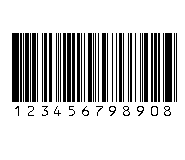Matrix 2 of 5 Barcodes
Matrix 2 of 5
Matrix 2 of 5 is part of the 2 of 5 barcode family, but encodes data at a higher density than its counterparts. It was first developed by the Nieaf Company in Holland and is sometimes called the 2 of 5 Matrix or 2/5 3 Bar Matrix. Despite its ability to encode more data in a smaller space, this code is rarely used since other variants offer greater benefits around accuracy and reliability. In addition, Matrix 2 of 5 barcodes require greater printing precision to ensure they remain readable over time.

Format
Unlike traditional 2 of 5 formats that only use bars to encode information, Matrix 2 of 5 is interleaved, meaning it uses both bars and spaces to encode information. Each digit is encoded in either five bars, two of which are wide and three of which are narrow, or five spaces which have a similar wide/narrow ratio. Digits are encoded in pairs so that five bars and five spaces create a set of two digits. A zero is often added if no first digit is required. This barcode format only supports numeric characters 0-9.
There are six key elements in Matrix 2 of 5 barcodes:
- A Leading Quiet Zone at Least 10x the Width of a Narrow Bar
- One Start Character
- All Data Characters
- One Stop Character
- A Trailing Quiet Zone
- An Optional Check Digit Based on the Modulo 10 (Mod 10) Algorithm
Matrix 2 of 5 barcodes may also contain human-readable text underneath the barcode itself, but this is not a requirement.

Common Use Cases
Matrix 2 of 5 barcodes are occasionally used in warehouse applications, but other options such as Industry 2 of 5, Interleaved 2 of 5, or ITF-14/SCC-1 are generally preferred because of their improved readability and accuracy. While Matrix 2 of 5 codes come with the benefit of improved information density, the type doesn’t offer any other significant advantages over more common 2 of 5 symbology sets.